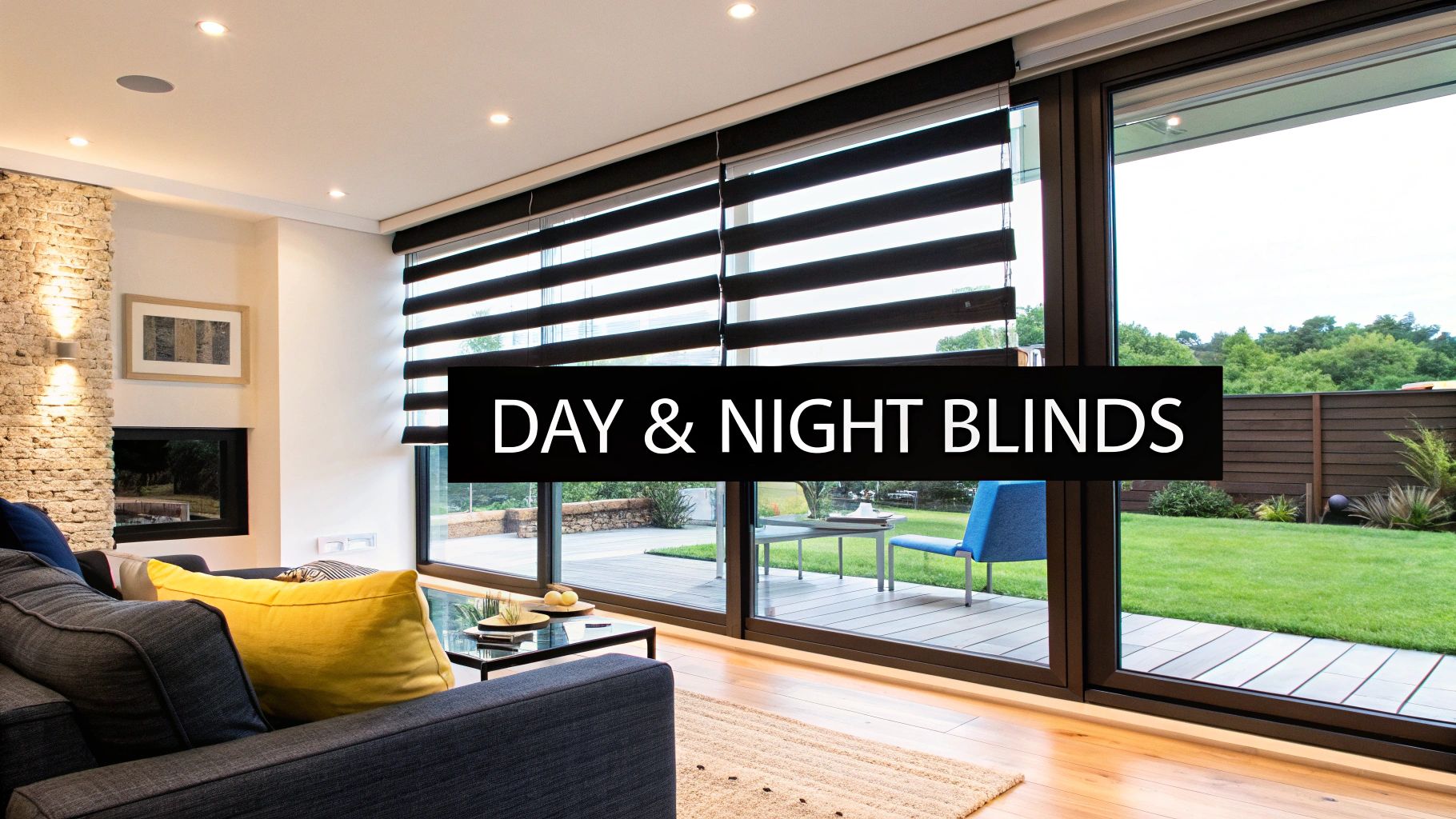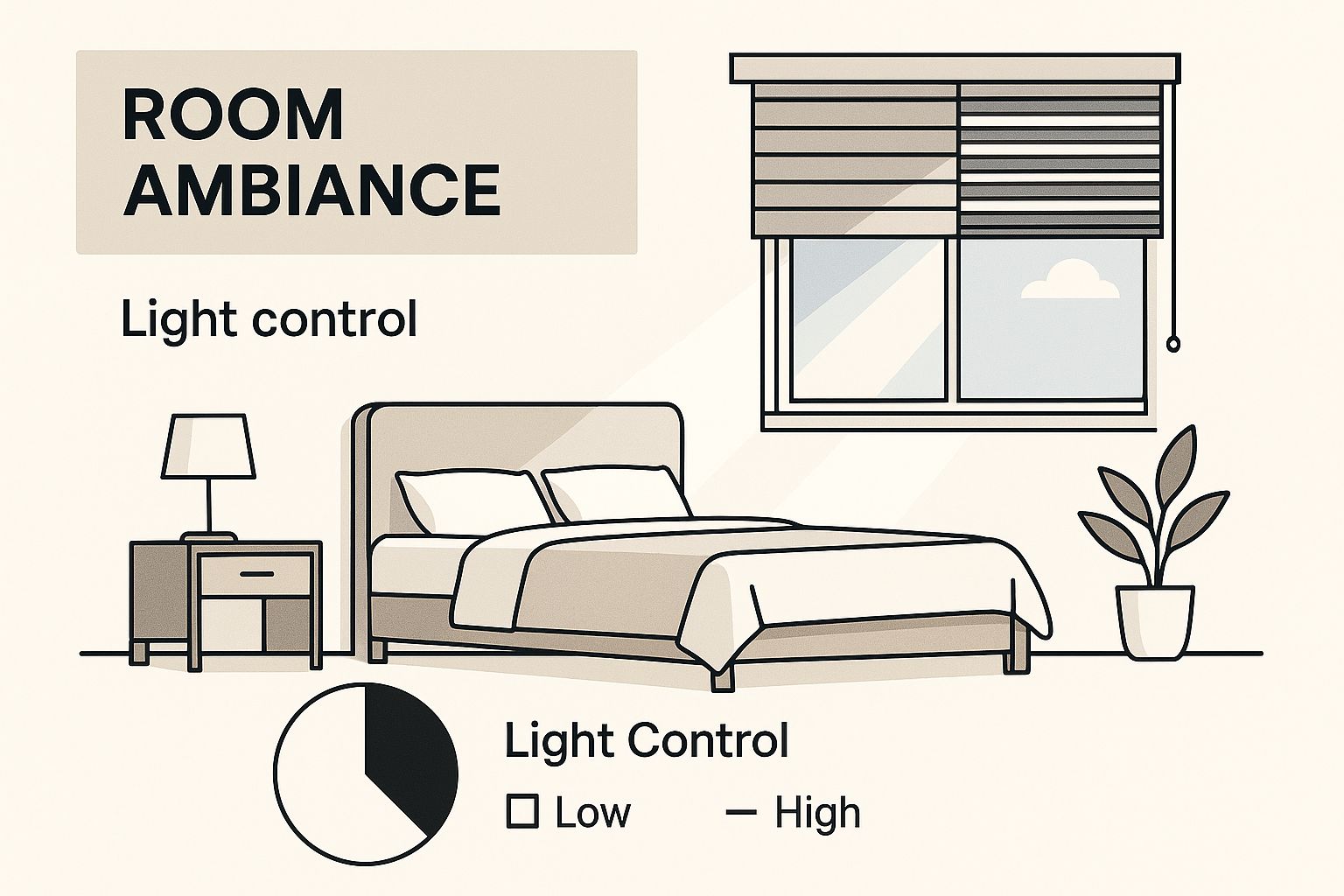What Are Day and Night Blinds? Discover Stylish Light Control
- Blindsmart im
- Oct 16
- 10 min read
Ever wondered how to get that perfect balance of natural light and privacy without constantly fiddling with your blinds? Meet day and night blinds, one of the most clever and stylish window treatments on the market. You might have also heard them called zebra blinds, and for good reason.
Your Guide to Day and Night Blinds

Think of them as a dimmer switch for your windows. Instead of a stark choice between fully open or completely shut, you get to fine-tune the room's atmosphere with one simple control. This guide will walk you through everything, making it easy to see if they're the right fit for your home.
Their popularity across the UK has surged recently, and it’s no surprise. The demand for functional yet beautiful window coverings is clear, with the market for blinds and shades valued at USD 1.32 billion back in 2022 and still growing. People are looking for smarter, more versatile solutions, and these blinds deliver. You can read more about the UK blinds and shades market trends to see just how much this area is expanding.
What You Will Learn
We’ve put together a complete overview to help you get to grips with these fantastic blinds. We’ll explore:
How they work: The ingenious design behind their alternating sheer and solid fabric stripes.
Key benefits: From gently filtering sunlight to giving you total privacy when you need it.
Style choices: Finding the perfect colour and texture to complement your décor.
Practical tips: A few pointers on installation and keeping them looking pristine.
Day and night blinds offer a sleek, modern alternative to more traditional options. While they operate on a principle similar to roller blinds, their dual-layer fabric is what truly makes them special. If you're exploring different window treatments, it's also worth looking into other innovative designs like illusion and panel blinds to compare your options.
How Do Day and Night Blinds Actually Work?
The magic behind day and night blinds is beautifully simple. It all comes down to a single loop of fabric made from alternating horizontal stripes – one sheer, the other opaque. This clever design is the secret to their incredible flexibility.
When you pull the control chain or use the remote, this fabric loop glides, moving the front layer of stripes over the back layer. It’s this straightforward movement that gives you such fine-tuned control over the light and feel of your room.
The Mechanics of Light Control
Think of it like this: imagine you have two combs. If you line up the teeth perfectly, you can see right through. But if you shift one slightly, the teeth of one comb block the gaps in the other. Day and night blinds work on a very similar principle.
To let in soft, natural light: You simply align the sheer stripes on the front layer with the sheer stripes on the back. This "opens" the blind, letting daylight filter into the room while still giving you a measure of privacy.
For privacy and darkness: Adjust the blind so the solid, opaque stripes on the front cover the sheer stripes on the back. This creates a solid block of colour, completely blocking the view from outside and making the room much darker.
This dual-layer system is precisely why they've become such a popular choice for homes and offices all over the UK. Their ability to deliver precise light control without needing a second set of curtains is a real game-changer. For a deeper dive, you can explore the latest research on the window blinds market.
In essence, this elegant solution gives you the functionality of three different window coverings in one. You get a light-filtering screen, a privacy shade, and a near-blackout blind, all without any of the bulk or fuss.
This means you can change the entire mood of a room in seconds. Go from a bright, airy space for your morning coffee to a private, cosy setting for a film night, all with one stylish blind.
The Real Benefits of Day and Night Blinds
It's one thing to understand how day and night blinds work, but the real magic is in what they can do for your home. Their clever design isn't just for show; it offers some seriously practical advantages that make them a fantastic choice for modern living.
The most noticeable benefit is the incredible control you get over lighting. Forget the all-or-nothing approach of traditional blinds. With a simple adjustment, you can transform a room’s atmosphere from bright and airy to cosy and private in seconds. It’s perfect for when you’re working from home and need to cut the glare, or settling down for a family film night.
This infographic really captures how they can completely change a room's feel.

As you can see, that dual-fabric system lets you glide smoothly from full daylight to a soft, diffused glow, which is the secret to their functional elegance.
More Than Just Good Looks
While their sleek, contemporary look is a huge plus, the advantages go much deeper than just aesthetics. That dual-layer fabric design also brings a surprising boost in energy efficiency.
By creating an insulating barrier at your window, these blinds help trap warmth during the colder months and block out the intense summer sun. It's a small change that can make a real difference to your home's comfort and even your energy bills.
In fact, some regional energy efficiency studies have shown that well-fitted blinds like these can help reduce heat loss by up to 30%. This dual utility is a big reason why UK homeowners, who value both function and style, are increasingly drawn to them. For more details on this, you can read the full research on the UK window coverings market.
This extra layer of insulation makes them a great fit for bedrooms and living rooms where keeping a consistent, comfortable temperature is important. If temperature control is a top priority for you, it's also worth checking out our guide on thermal blackout roller blinds for home comfort.
Privacy Without Sacrificing Light
Here’s a common problem: you want privacy, but you don't want to live in a cave. Standard blinds and curtains often force you to choose one or the other.
This is where day and night blinds truly shine. You can simply align the opaque stripes to block the view from outside while still letting soft, natural light filter through the sheer panels. No more gloominess.
This makes them an ideal solution for all sorts of spaces:
Ground-floor rooms: Stop passers-by from peering in without making your living room feel boxed in.
Home offices: Cut down on screen glare while keeping your workspace bright and energising.
Bathrooms: Get total privacy when you need it, but still enjoy natural daylight.
To put it all into perspective, let's see how day and night blinds stack up against more traditional window treatments.
Day and Night Blinds vs Traditional Window Coverings
The table below offers a quick snapshot of where day and night blinds excel compared to Venetian blinds and classic curtains.
Feature | Day & Night Blinds | Venetian Blinds | Curtains |
|---|---|---|---|
Light Control | Precision filtering (sheer/opaque) | Tilting slats for directional light | Basic (open/closed), limited filtering |
Privacy | High, customisable without losing light | Good, but can have gaps between slats | High when closed, but blocks all light |
Insulation | Good, due to dual-layer fabric | Moderate, some air gap control | Good to excellent, depending on fabric |
Aesthetics | Modern, sleek, and minimalist | Classic and functional | Traditional, wide variety of styles |
Maintenance | Easy to dust and wipe clean | Slats can be tricky to clean | Requires washing or dry cleaning |
While every option has its place, it's clear that day and night blinds offer a unique combination of fine-tuned light control and privacy that's hard to beat.
How to Choose the Perfect Day and Night Blinds
Picking out the right day and night blinds goes beyond just settling on a colour you like. It’s really about finding that sweet spot where function and style meet your room’s unique needs, making sure they look great and work perfectly for you.
With a few key things to think about, you can easily find the ideal fit.
First up, let's talk fabric. While the whole point of day and night blinds is the alternating sheer and solid stripes, the material of those solid sections can make a huge difference to your room. For a living room or kitchen, a standard light-filtering fabric is usually spot-on, giving you privacy without plunging the space into darkness.
But for a bedroom or a media room? You’ll want to go for a blackout fabric. This option is a game-changer, providing maximum darkness when you align the opaque stripes. It’s perfect for creating a restful environment for sleep or kicking back to watch a film without any pesky glare on the screen.
Find Your Perfect Style and Fit
Once you’ve got the fabric sorted, the fun part begins: choosing the colour and texture. Day and night blinds come in an incredible range of shades, from clean, crisp whites and versatile greys to vibrant, eye-catching colours. Have a think about your current decor – are you looking for blinds that will blend in, or do you want them to be a standout feature?
The next critical step is getting the size right. You’ve got two main routes to go down here:
Ready-made sizes: A great budget-friendly option that works well for standard-sized windows.
Made-to-measure: This is your ticket to a flawless, bespoke fit for your window, ensuring no awkward gaps and a professional, polished look.
A made-to-measure blind doesn't just look smarter; it performs better too, especially when it comes to blocking light and improving insulation. Think of it as an investment in getting the look and function just right.
Selecting the Right Control System
Finally, you need to decide how you'll operate your blinds. This choice affects your daily convenience more than you might think. A traditional cord or chain is the classic choice – it's simple, reliable, and does the job perfectly for most windows.
If you’re after a more modern touch and ultimate convenience, motorised blinds are a fantastic upgrade. A simple click of a remote is all it takes to adjust your blinds, which is a lifesaver for high or hard-to-reach windows. Many systems can even be linked up to your smart home for voice control or automated schedules.
While you're weighing your options, you might also find that double roller blinds offer a similar level of light control, just with a slightly different design. To see how they stack up, take a look at our guide on roller and double roller blinds.
A Simple Guide to Installation and Care

You might think a blind this stylish must be a pain to install or a nightmare to look after. Thankfully, that's not the case at all. Day and night blinds are actually designed to be fitted easily and are surprisingly low-maintenance, making them a really practical choice for almost any home.
For the most part, installation is a straightforward DIY job. Your blinds will arrive with all the brackets and instructions you need, and you can choose to fit them either inside the window recess or on the outside. Of course, if you're not a fan of DIY or have particularly large windows, a professional fitting service will guarantee a perfect finish.
Keeping Your Blinds Looking Fresh
Maintaining that brand-new look is incredibly simple and takes very little effort. A bit of regular, gentle care is all it takes to keep them looking pristine for years.
For day-to-day cleaning, a quick dust is usually all they need. You can use:
A microfibre cloth: Just give each stripe a gentle wipe to get rid of any dust.
A feather duster: A quick flick over them once a week will stop dust from settling in the first place.
The brush attachment on your hoover: Pop it on the lowest suction setting and carefully vacuum the fabric.
The real secret is just being consistent. A light dusting every week or so is the best way to stop grime from building up, which saves you from having to do a deep clean later on.
If you happen to get a small mark or spill on the fabric, spot-cleaning is the way to go. Just dampen a clean cloth with some lukewarm water and maybe a tiny bit of mild soap. Gently dab the spot—don't scrub it, as that could damage the material. Let it air-dry, and you’re done. It’s a simple routine that keeps your blinds looking great without eating into your time.
A Few Final Questions
Before you decide, let's clear up some of the common questions people ask about day and night blinds. Getting these details straight will help you feel completely confident that you’re making the right choice for your home.
Are Day and Night Blinds Good for Bedrooms?
They're a fantastic option for bedrooms, especially if you go for a blackout fabric. When you line up the solid stripes, they do an excellent job of blocking out most of the daylight, creating a dark, peaceful space that’s perfect for a good night's sleep. It's a massive improvement over standard light-filtering blinds.
That said, they aren’t quite the same as a dedicated blackout roller blind that sits tightly in a cassette frame. You might get tiny hints of light peeking around the very edges. For most people, though, the darkness they provide is more than enough for a restful bedroom.
The real beauty is getting two blinds in one: a dark room for sleeping and softly filtered natural light during the day, all from a single, elegant blind.
Can People See In at Night?
This is a great question and it all comes down to how you set the blinds. If you leave the sheer stripes open to let light through, then yes, someone outside would be able to make out shadows and general shapes inside once you have your lights on.
But the moment you shift the stripes to the "night" position, where the solid panels overlap, you create a complete visual barrier. In this mode, your privacy is total. No one can see in, so you can relax in complete comfort every evening.
Is It Tricky to Measure for Day and Night Blinds?
Not at all! Getting the measurements right is crucial for a perfect fit, but the process is straightforward and exactly the same as for a standard roller blind. The main thing to decide is whether you want the blind to fit inside the window recess or hang on the outside.
For an inside fit: Measure the width and the drop at three different points inside the recess. Simply use the smallest of the three measurements for a perfect fit.
For an outside fit: Measure the recess itself, then add at least 7-10cm to both the width and the drop. This ensures the blind fully covers the window for better light control.
Taking a few minutes to be precise here makes all the difference and gives you a professional-looking finish.
Ready to find the perfect balance of light and privacy for your home? Explore our stunning collection of made-to-measure window coverings at Blindsmart.

Comments